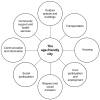The Challenges of Urban Ageing: Making Cities Age-Friendly in Europe
- PMID: 30714577
- PMCID: PMC6266083
- DOI: 10.3390/ijerph15112473
The Challenges of Urban Ageing: Making Cities Age-Friendly in Europe
Abstract
Urban ageing is an emerging domain that deals with the population of older people living in cities. The ageing of society is a positive yet challenging phenomenon, as population ageing and urbanisation are the culmination of successful human development. One could argue whether the city environment is an ideal place for people to grow old and live at an old age compared to rural areas. This viewpoint article explores and describes the challenges that are encountered when making cities age-friendly in Europe. Such challenges include the creation of inclusive neighbourhoods and the implementation of technology for ageing-in-place. Examples from projects in two age-friendly cities in The Netherlands (The Hague) and Poland (Cracow) are shown to illustrate the potential of making cities more tuned to the needs of older people and identify important challenges for the next couple of years. Overall, the global ageing of urban populations calls for more age-friendly approaches to be implemented in our cities. It is a challenge to prepare for these developments in such a way that both current and future generations of older people can benefit from age-friendly strategies.
Keywords: Poland; The Netherlands; cities; dementia-friendly; housing; older adults; older people; technology.
Conflict of interest statement
The authors declare no conflict of interest.
Figures
Similar articles
-
"Who Doesn't Think about Technology When Designing Urban Environments for Older People?" A Case Study Approach to a Proposed Extension of the WHO's Age-Friendly Cities Model.Int J Environ Res Public Health. 2019 Sep 20;16(19):3525. doi: 10.3390/ijerph16193525. Int J Environ Res Public Health. 2019. PMID: 31547204 Free PMC article.
-
Is a healthy city also an age-friendly city?Health Promot Int. 2015 Jun;30 Suppl 1:i108-i117. doi: 10.1093/heapro/dav039. Health Promot Int. 2015. PMID: 26069312
-
Exploring the role of smart cities in supporting ageing-in-place in Chongqing, China.Australas J Ageing. 2024 Jun;43(2):264-270. doi: 10.1111/ajag.13301. Epub 2024 Mar 19. Australas J Ageing. 2024. PMID: 38500440
-
Age-friendly cities of Europe.J Urban Health. 2013 Oct;90 Suppl 1(Suppl 1):116-28. doi: 10.1007/s11524-012-9765-8. J Urban Health. 2013. PMID: 22993036 Free PMC article. Review.
-
The Role of Mobility Digital Ecosystems for Age-Friendly Urban Public Transport: A Narrative Literature Review.Int J Environ Res Public Health. 2020 Oct 14;17(20):7465. doi: 10.3390/ijerph17207465. Int J Environ Res Public Health. 2020. PMID: 33066528 Free PMC article. Review.
Cited by
-
Best Practices from Eight European Dementia-Friendly Study Cases of Innovation.Int J Environ Res Public Health. 2022 Oct 31;19(21):14233. doi: 10.3390/ijerph192114233. Int J Environ Res Public Health. 2022. PMID: 36361113 Free PMC article.
-
The Problem of Monitoring the Psycho-Physical Condition of Seniors during Proposed Activities in Urban Space.Sensors (Basel). 2023 Feb 1;23(3):1602. doi: 10.3390/s23031602. Sensors (Basel). 2023. PMID: 36772642 Free PMC article.
-
Implications of Aging in Place in the Context of the Residential Environment: Bibliometric Analysis and Literature Review.Int J Environ Res Public Health. 2023 Oct 10;20(20):6905. doi: 10.3390/ijerph20206905. Int J Environ Res Public Health. 2023. PMID: 37887643 Free PMC article. Review.
-
Person-Environment Fit in Urban Neighbourhoods in Slovenia: Challenges and Coping Strategies.Int J Environ Res Public Health. 2023 Mar 14;20(6):5139. doi: 10.3390/ijerph20065139. Int J Environ Res Public Health. 2023. PMID: 36982047 Free PMC article.
-
Friendly Residential Environments and Subjective Well-Being in Older People with and without Help Needs.Int J Environ Res Public Health. 2022 Nov 28;19(23):15832. doi: 10.3390/ijerph192315832. Int J Environ Res Public Health. 2022. PMID: 36497900 Free PMC article.
References
-
- Van Hoof J., Kazak J.K. Urban ageing. Indoor Built Environ. 2018;27:583–586. doi: 10.1177/1420326X18768160. - DOI
-
- Buffel T., Phillipson C. Can global cities be ‘age-friendly cities’? Urban development and ageing populations. Cities. 2016;55:94–100. doi: 10.1016/j.cities.2016.03.016. - DOI
-
- Phillips D.R., Feng Z. Global ageing. In: Skinner M.W., Andrews G.J., Cutchin M.P., editors. Geographical Gerontology. Perspectives, Concepts, Approaches. Routledge; London, UK: 2018. pp. 93–109.
-
- OECD . Ageing in Cities. OECD Publishing; Paris, France: 2015.
MeSH terms
LinkOut - more resources
Full Text Sources
Medical


